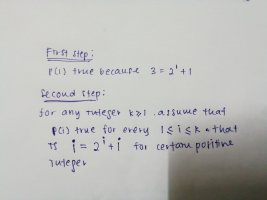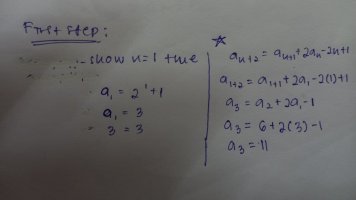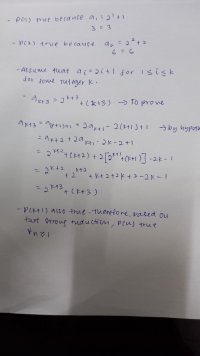Hi, im new college student learn calculus. i already watch the video from youtube and so on but i still cannot understand how to solve this.. Can someone explain using strong induction how to prove [math]a_1=3,a_2=6\space and\space a_n+_2=a_n+_1\space+2a_n-2n+1\space so\space a_n=2^n+n\space for\space every\space integer\space n≥1[/math]
You are using an out of date browser. It may not display this or other websites correctly.
You should upgrade or use an alternative browser.
You should upgrade or use an alternative browser.
Mathematical induction
- Thread starter Leons
- Start date
lev888
Elite Member
- Joined
- Jan 16, 2018
- Messages
- 2,993
What do you know about induction? Have you used it before? Can you list the steps of an induction proof and do the first one?Hi, im new college student learn calculus. i already watch the video from youtube and so on but i still cannot understand how to solve this.. Can someone explain using strong induction how to prove [math]a_1=3,a_2=6\space and\space a_n+_2=a_n+_1\space+2a_n-2n+1\space so\space a_n=2^n+n\space for\space every\space integer\space n≥1[/math]
it have 3 steps. First induction basis, show that p(1) true. Second induction hypothesis, assume that n=k true. Third, induction step, prove that n=k+1 true.. i just only used this step before, for the strong induction i haven't used it.. i will try first.. can you check if my answer correct or not.. im still confuse for the step number 3What do you know about induction? Have you used it before? Can you list the steps of an induction proof and do the first

Last edited:
lev888
Elite Member
- Joined
- Jan 16, 2018
- Messages
- 2,993
Doesn't look right to me.it have 3 steps. First induction basis, show that p(1) true. Second induction hypothesis, assume that n=k true. Third, induction step, prove that n=k+1 true.. i just only used this step before, for the strong induction i haven't used it.. i will try first.. can you check if my answer correct or not.. im still blank for the step number 3
View attachment 29930
You have a sequence defined recursively - each terms is defined through 2 previous terms. You need to prove that each term also follows the second, explicit, definition.
In the first step you need to show that the above is true for n=1. Plug in n=1 into both definitions and show that they produce the same result.
Dr.Peterson
Elite Member
- Joined
- Nov 12, 2017
- Messages
- 16,871
oh, I see... this one, is it correct? and for the one that i starred, is it I have to write it too?Doesn't look right to me.
You have a sequence defined recursively - each terms is defined through 2 previous terms. You need to prove that each term also follows the second, explicit, definition.
In the first step you need to show that the above is true for n=1. Plug in n=1 into both definitions and show that they produce the same result.

Actually i dont quite understand what im write for the step 2.. =( is this what you mean?Since each term is defined in terms of the two previous terms, in your induction step you will need to have two previous cases known to be true. So the base case to be verified will cover both i=1 and i=2. Then the inductive step will use the recursion.
Also, you don't really mean this, do you?
View attachment 29931

Dr.Peterson
Elite Member
- Joined
- Nov 12, 2017
- Messages
- 16,871
You are right about the base case; 3 and 6 are given, and you've shown that the formula yields them.Actually i dont quite understand what im write for the step 2.. =( is this what you mean?View attachment 29934
But the inductive step is to assume that [imath]a_i = 2^i+i[/imath], not for every [imath]i\ge 1[/imath], which is what you are to prove, but for every [imath]1\le i\le k[/imath] for some given k, and use that to prove that it is true for the next case, namely [imath]a_{k+1} = 2^{k+1}+(k+1)[/imath].
So, what does the definition say [imath]a_{k+1}[/imath], using the formula for the two preceding terms? Try to manipulate that to look like [imath]2^{k+1}+(k+1)[/imath].
No, you don't need to show the value of [imath]a_3[/imath]; you'll be using the definition in the inductive step.oh, I see... this one, is it correct? and for the one that i starred, is it I have to write it too?View attachment 29932
The problem is oddly worded, but clearly says to use strong induction. Here is how I would set it up.
[math]\text {PROVE P(n) such that } a_n = 2^n + n \text { for every positive integer } n, \text {given }[/math]
[math]a_1 = 3, \ a_2 = 6 \text { and } a_n = a_{n-1} + 2a_{n-2} - 2n + 1 \text { for n } \ge 3.[/math]
[math]\text {Step I: } n = 1 \implies a_n = 3 = 2 + 1 = 2^1 + 1 = 2^n + n.\\ n = 2 \implies a_n = 6 = 4 + 2 = 2^2 + 2 = 2^n + n \implies \\ \text {P(n) is true for every positive integer} \le 2.[/math]
[math]\text {STEP II: Thus, there exists a positive integer } k \ge 2\\ \text { such that P(j) is true for every positive integer} \le k.[/math]
[math]k + 1 \text { is an integer} \ge 3 \text { because } k \text { is an integer} \ge 2.[/math]
[math]a_{k+1} = a_{(k+1)-1} + 2a_{(k+1)-2} - 2\{(k + 1) - 2\} + 1 \text { by hypothesis.}[/math]
[math]\therefore a_{k+1} = a_k + 2a_{k-1} - 2(k - 1) + 1 =\\ (2^k + k) + 2\{2^{(k - 1)} + (k - 1)\} - 2k + 2 + 1 =\\ 2^k + k + 2 * 2^{(k-1)} +2k - 2 - 2k + 3 =\\ 2^k + 2^k + 3k - 2k + 3 - 2 =\\ 2 * 2^k + k + 1 =\\ 2^{(k + 1)} + (k + 1).[/math]
Do you see where the need for strong induction comes in?
[math]\text {PROVE P(n) such that } a_n = 2^n + n \text { for every positive integer } n, \text {given }[/math]
[math]a_1 = 3, \ a_2 = 6 \text { and } a_n = a_{n-1} + 2a_{n-2} - 2n + 1 \text { for n } \ge 3.[/math]
[math]\text {Step I: } n = 1 \implies a_n = 3 = 2 + 1 = 2^1 + 1 = 2^n + n.\\ n = 2 \implies a_n = 6 = 4 + 2 = 2^2 + 2 = 2^n + n \implies \\ \text {P(n) is true for every positive integer} \le 2.[/math]
[math]\text {STEP II: Thus, there exists a positive integer } k \ge 2\\ \text { such that P(j) is true for every positive integer} \le k.[/math]
[math]k + 1 \text { is an integer} \ge 3 \text { because } k \text { is an integer} \ge 2.[/math]
[math]a_{k+1} = a_{(k+1)-1} + 2a_{(k+1)-2} - 2\{(k + 1) - 2\} + 1 \text { by hypothesis.}[/math]
[math]\therefore a_{k+1} = a_k + 2a_{k-1} - 2(k - 1) + 1 =\\ (2^k + k) + 2\{2^{(k - 1)} + (k - 1)\} - 2k + 2 + 1 =\\ 2^k + k + 2 * 2^{(k-1)} +2k - 2 - 2k + 3 =\\ 2^k + 2^k + 3k - 2k + 3 - 2 =\\ 2 * 2^k + k + 1 =\\ 2^{(k + 1)} + (k + 1).[/math]
Do you see where the need for strong induction comes in?
oh okay,, can you check if my answer is correct or not?You are right about the base case; 3 and 6 are given, and you've shown that the formula yields them.
But the inductive step is to assume that [imath]a_i = 2^i+i[/imath], not for every [imath]i\ge 1[/imath], which is what you are to prove, but for every [imath]1\le i\le k[/imath] for some given k, and use that to prove that it is true for the next case, namely [imath]a_{k+1} = 2^{k+1}+(k+1)[/imath].
So, what does the definition say [imath]a_{k+1}[/imath], using the formula for the two preceding terms? Try to manipulate that to look like [imath]2^{k+1}+(k+1)[/imath].
No, you don't need to show the value of [imath]a_3[/imath]; you'll be using the definition in the inductive step.

Dr.Peterson
Elite Member
- Joined
- Nov 12, 2017
- Messages
- 16,871
The main work is good, but some of the details are off. Why do you assume it's true through k, but then leap to k+3?oh okay,, can you check if my answer is correct or not?View attachment 29968
I think he is talking about (k + 1) + 2. Stopped me for a second as well.The main work is good, but some of the details are off. Why do you assume it's true through k, but then leap to k+3?
Dr.Peterson
Elite Member
- Joined
- Nov 12, 2017
- Messages
- 16,871
But this applies the hypothesis to the cases k+1 and k+2, which isn't assumed to be true:I think he is talking about (k + 1) + 2. Stopped me for a second as well.
He only assumes it through k:
lev888
Elite Member
- Joined
- Jan 16, 2018
- Messages
- 2,993
The first step doesn't make sense. You need to show that the 2 definitions produce the same value for n=1. Don't see it.oh okay,, can you check if my answer is correct or not?View attachment 29968
Dr.Peterson
Elite Member
- Joined
- Nov 12, 2017
- Messages
- 16,871
a1 and a2 are defined as 3 and 6 respectively; Leons showed that the formula to be proved gives those values.The first step doesn't make sense. You need to show that the 2 definitions produce the same value for n=1. Don't see it.
lev888
Elite Member
- Joined
- Jan 16, 2018
- Messages
- 2,993
I assumed we had to start with [imath]a_n+_2[/imath], which is [imath]a_3[/imath] for n=1. But, yes, you are right, the first term according to the other formula is [imath]a_1[/imath].a1 and a2 are defined as 3 and 6 respectively; Leons showed that the formula to be proved gives those values.



